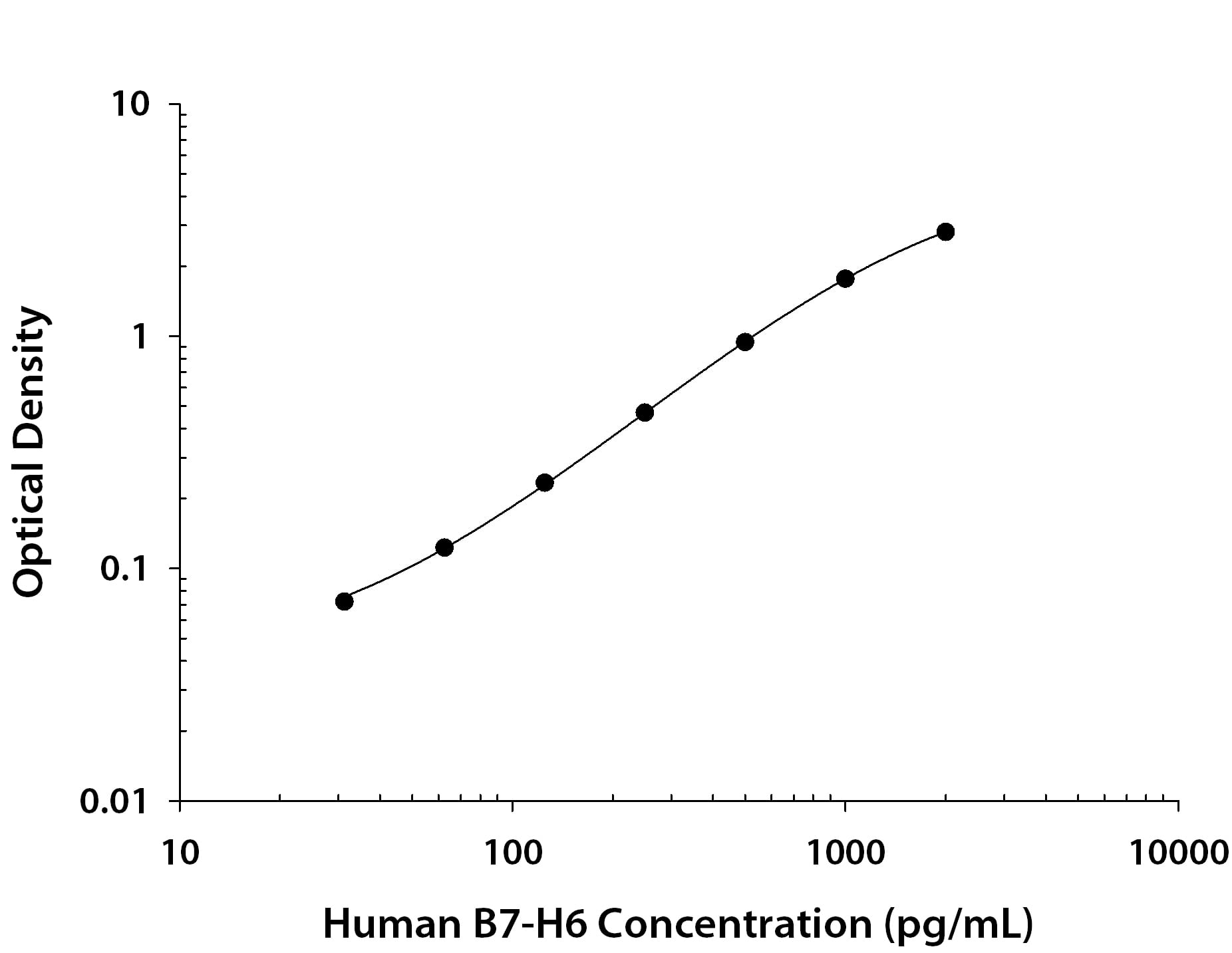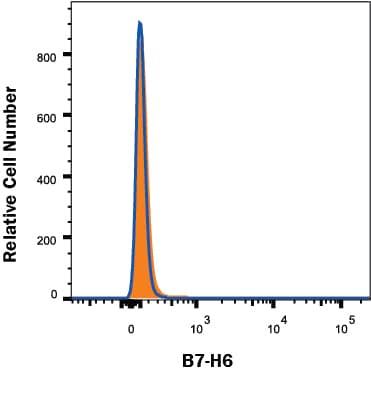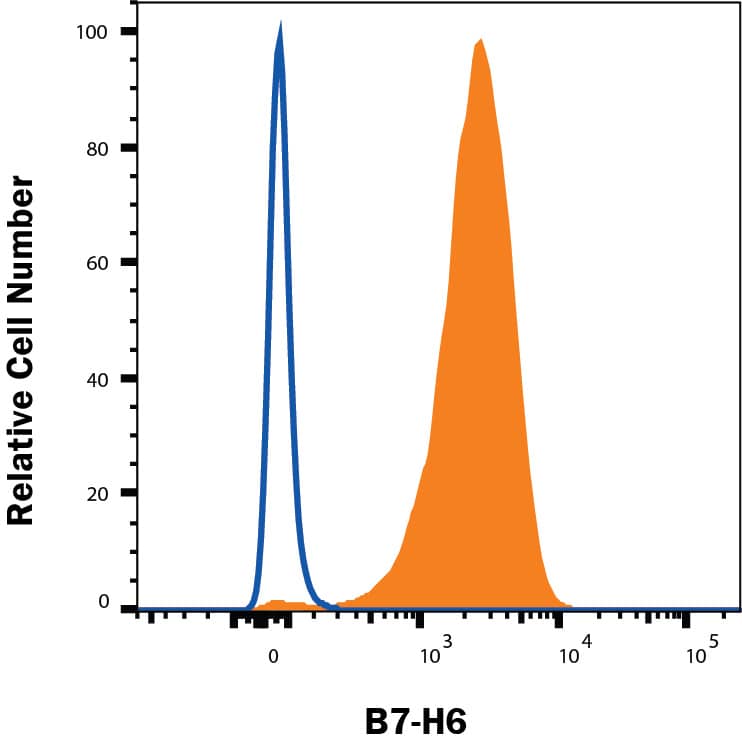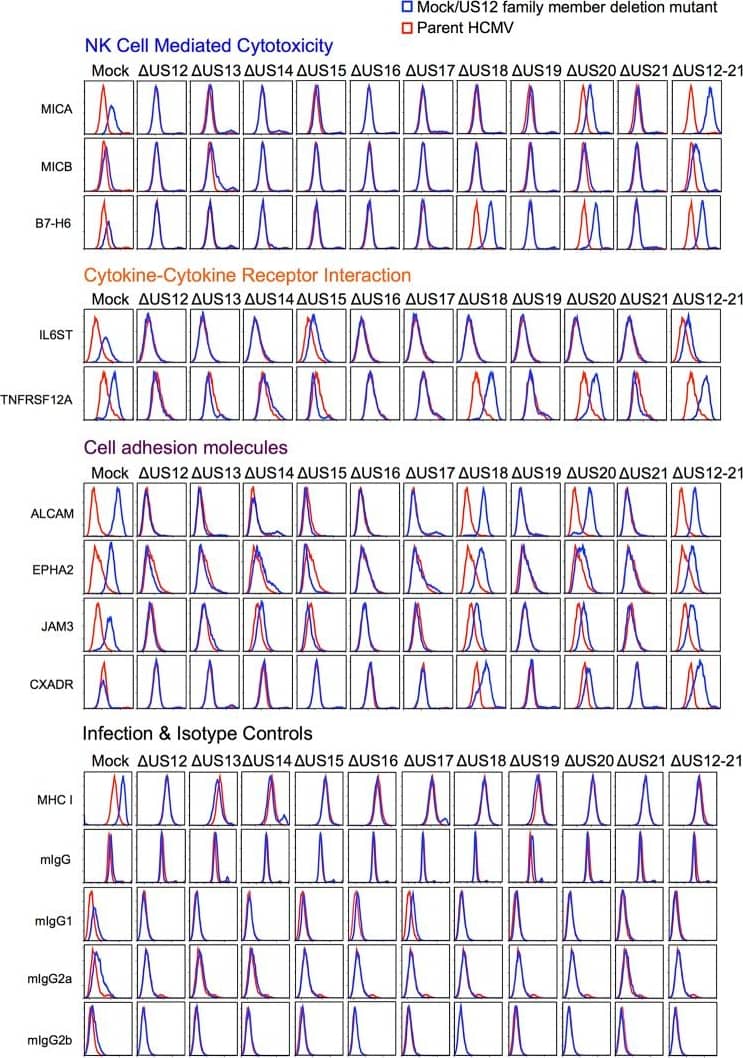Human B7-H6 Antibody
R&D Systems, part of Bio-Techne | Catalog # MAB7144


Conjugate
Catalog #
Key Product Details
Validated by
Knockout/Knockdown
Species Reactivity
Validated:
Human
Cited:
Human
Applications
Validated:
CyTOF-ready, ELISA, Flow Cytometry, Knockout Validated
Cited:
Flow Cytometry
Label
Unconjugated
Antibody Source
Monoclonal Mouse IgG1 Clone # 875001
Product Specifications
Immunogen
Mouse myeloma cell line NS0-derived recombinant human B7-H6
Met1-Ser262
Accession # Q68D85
Met1-Ser262
Accession # Q68D85
Specificity
Detects human B7-H6 in ELISA.
Clonality
Monoclonal
Host
Mouse
Isotype
IgG1
Scientific Data Images for Human B7-H6 Antibody
Human B7‑H6 ELISA Standard Curve.
Recombinant Human B7-H6 protein was serially diluted 2-fold and captured by Mouse Anti-Human B7-H6 Monoclonal Antibody (Catalog # MAB7144) coated on a Clear Polystyrene Microplate (DY990). Mouse Anti-Human B7-H6 Monoclonal Antibody (MAB71442) was biotinylated and incubated with the protein captured on the plate. Detection of the standard curve was achieved by incubating Streptavidin-HRP (DY998) followed by Substrate Solution (Catalog # DY999) and stopping the enzymatic reaction with Stop Solution (DY994).B7-H6 Specificity is Shown by Flow Cytometry in Knockout Cell Line.
B7-H6 knockout HeLa human cervical epithelial carcinoma cell line was stained with Mouse Anti-Human B7-H6 Monoclonal Antibody (Catalog # MAB7144, filled histogram) or isotype control antibody (MAB002, open histogram) followed by anti-Mouse IgG PE-conjugated secondary antibody (F0102B). No staining in the B7-H6 knockout HeLa cell line was observed. View our protocol for Staining Membrane-associated Proteins.Detection of B7-H6 in K562 cells by Flow Cytometry.
K562 cells were stained with Mouse Anti-Human B7-H6 Monoclonal Antibody (Catalog # MAB7144, filled histogram) or isotype control antibody (Catalog # MAB002, open histogram), followed by Phycoerythrin-conjugated Anti-Mouse IgG Secondary Antibody (Catalog # F0102B). View our protocol for Staining Membrane-associated Proteins.Applications for Human B7-H6 Antibody
Application
Recommended Usage
CyTOF-ready
Ready to be labeled using established conjugation methods. No BSA or other carrier proteins that could interfere with conjugation.
ELISA
This antibody functions as an ELISA capture antibody when paired with Mouse Anti-Human B7‑H6 Monoclonal Antibody (Catalog # MAB71442).
This product is intended for assay development on various assay platforms requiring antibody pairs. We recommend the Human B7-H6 DuoSet ELISA (Catalog # DY7144-05) for convenient development of a sandwich ELISA.
Flow Cytometry
0.25 µg/106 cells
Sample: K562 human chronic myelogenous leukemia cell line
Sample: K562 human chronic myelogenous leukemia cell line
Knockout Validated
B7-H6 is specifically detected in HeLa human cervical epithelial carcinoma parental cell line but is not detectable in B7-H6 knockout HeLa cell line.
Formulation, Preparation, and Storage
Purification
Protein A or G purified from hybridoma culture supernatant
Reconstitution
Reconstitute at 0.5 mg/mL in sterile PBS. For liquid material, refer to CoA for concentration.
Formulation
Lyophilized from a 0.2 μm filtered solution in PBS with Trehalose. *Small pack size (SP) is supplied either lyophilized or as a 0.2 µm filtered solution in PBS.
Shipping
Lyophilized product is shipped at ambient temperature. Liquid small pack size (-SP) is shipped with polar packs. Upon receipt, store immediately at the temperature recommended below.
Stability & Storage
Use a manual defrost freezer and avoid repeated freeze-thaw cycles.
- 12 months from date of receipt, -20 to -70 °C as supplied.
- 1 month, 2 to 8 °C under sterile conditions after reconstitution.
- 6 months, -20 to -70 °C under sterile conditions after reconstitution.
Background: B7-H6
References
- Zou, W. and L. Chen (2008) Nat. Rev. Immunol. 8:467.
- Bour-Jordan, H. et al. (2011) Immunol. Rev. 241:180.
- Brandt, C.S. et al. (2009) J. Exp. Med. 206:1495.
- Li, Y. et al. (2011) J. Exp. Med. 208:703.
- Joyce, M.G. et al. (2011) Proc. Natl. Acad. Sci. 108:6223.
- Arnon, T.I. et al. (2006) Semin. Cancer Biol. 16:348.
- Byrd, A. et al. (2007) PLoS ONE 2:e1339.
Long Name
B7 Homolog 6
Alternate Names
B7H6, DKFZp686I21167, DKFZp686O24166, NCR3LG1
Gene Symbol
NCR3LG1
UniProt
Additional B7-H6 Products
Product Documents for Human B7-H6 Antibody
Product Specific Notices for Human B7-H6 Antibody
For research use only
